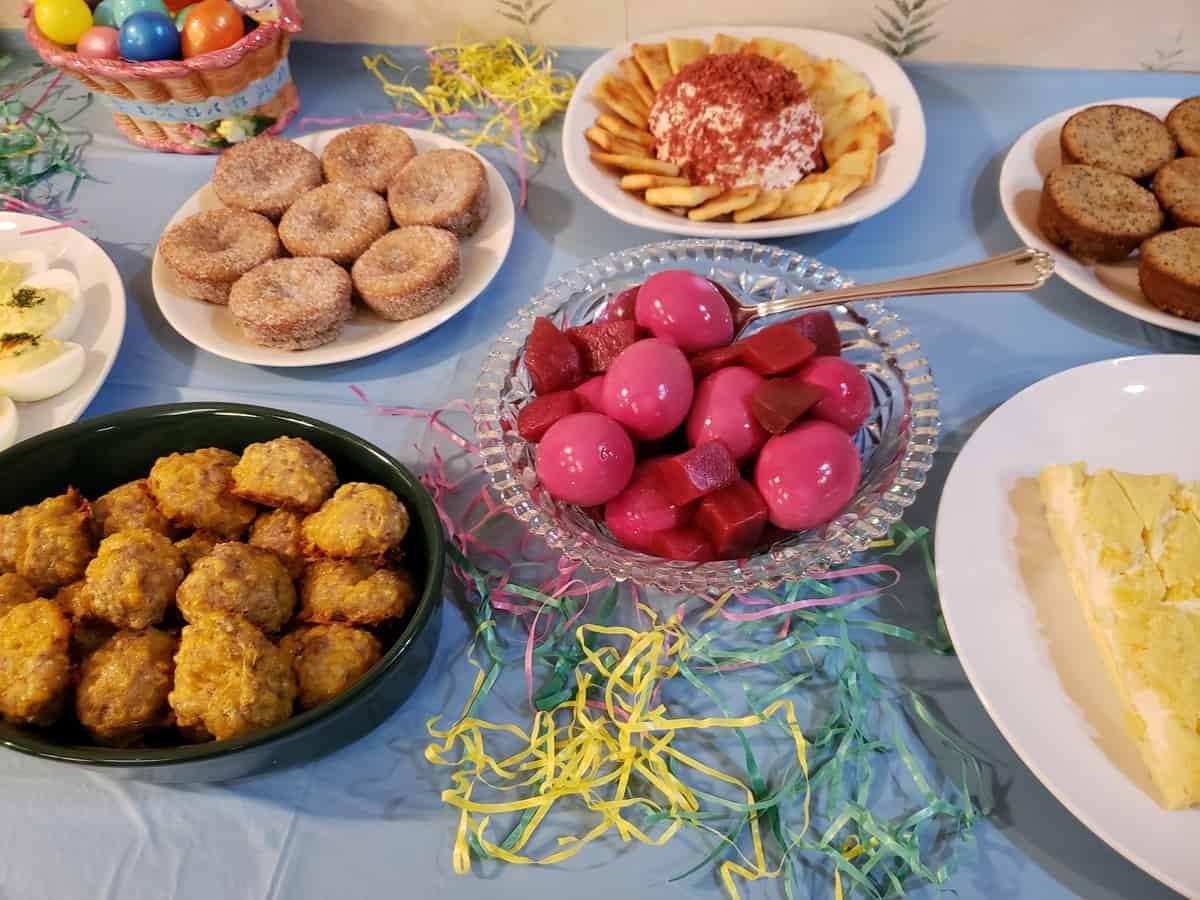Imagine a vibrant Easter brunch, brimming with delightful flavors and the joyous spirit of the holiday, yet perfectly aligned with your low-carb lifestyle. Forget the guilt-inducing carbs; this collection unveils a treasure trove of savory and sweet recipes designed to tantalize your taste buds without derailing your healthy eating goals. From elegant quiches bursting with fresh asparagus and nutty Gruyere to delicate, naturally sweetened desserts, this guide ensures a memorable Easter celebration that’s both delicious and satisfying.
We’ll explore creative low-carb bread alternatives, delve into the nutritional benefits of almond and coconut flour, and offer a step-by-step guide to crafting a stunning low-carb Easter egg cake. Detailed recipes, macronutrient balancing tips, and strategies for accommodating various dietary needs will transform your Easter brunch into a culinary masterpiece that caters to everyone.
Sweet Low-Carb Easter Brunch Treats

Indulge in the delightful flavors of Easter without sacrificing your low-carb lifestyle. These recipes utilize naturally sweet ingredients to create delectable desserts perfect for your Easter brunch. They showcase the versatility of almond and coconut flour, offering a guilt-free way to enjoy the sweetness of the season.
Naturally Sweetened Low-Carb Easter Desserts
These two recipes offer delicious, low-carb alternatives to traditional Easter sweets, relying on natural sweeteners like erythritol and stevia to keep the sugar content low.
Recipe 1: Raspberry Coconut Flour Muffins
- Ingredients: 1 cup coconut flour, 1/2 cup erythritol, 1/4 cup unsweetened shredded coconut, 2 large eggs, 1/4 cup melted coconut oil, 1 teaspoon baking powder, 1/2 teaspoon vanilla extract, 1/2 cup fresh raspberries.
- Instructions: Preheat oven to 350°F (175°C). Line a muffin tin with paper liners. In a large bowl, whisk together coconut flour, erythritol, and baking powder. In a separate bowl, whisk together eggs, melted coconut oil, and vanilla extract. Gently fold the wet ingredients into the dry ingredients until just combined. Fold in the shredded coconut and raspberries. Fill the muffin liners about 2/3 full. Bake for 15-20 minutes, or until a toothpick inserted into the center comes out clean. Let cool completely before serving.
Recipe 2: Almond Flour Lemon Poppy Seed Cake
- Ingredients: 1 1/2 cups almond flour, 1/2 cup erythritol, 1 teaspoon baking powder, 1/4 teaspoon salt, 2 large eggs, 1/4 cup melted butter, 1/4 cup unsweetened almond milk, 1 tablespoon lemon zest, 1 tablespoon poppy seeds, 1 teaspoon vanilla extract, Stevia to taste (optional).
- Instructions: Preheat oven to 350°F (175°C). Grease and flour an 8-inch cake pan. In a large bowl, whisk together almond flour, erythritol, baking powder, and salt. In a separate bowl, whisk together eggs, melted butter, almond milk, lemon zest, poppy seeds, and vanilla extract. Gradually add the wet ingredients to the dry ingredients, mixing until just combined. Pour batter into the prepared pan and bake for 25-30 minutes, or until a toothpick inserted into the center comes out clean. Let cool completely before serving. A light dusting of powdered erythritol can be added for a touch of sweetness.
Almond Flour and Coconut Flour in Low-Carb Baking
Almond flour and coconut flour are excellent choices for low-carb baking, each offering unique properties. Almond flour, made from blanched, ground almonds, provides a slightly nutty flavor and a tender crumb. Coconut flour, derived from dried coconut meat, is more absorbent and results in a denser texture.
Almond flour is ideal for cakes and muffins where a lighter, more delicate texture is desired. Its higher fat content contributes to a moist crumb. Coconut flour, due to its high absorbency, requires more liquid in recipes. It’s best suited for recipes where a denser texture, like in quick breads or cookies, is preferred. Both flours are naturally gluten-free, making them suitable for those with gluten sensitivities.
Low-Carb Easter Egg-Shaped Cake
This elegant cake is a showstopper for any Easter brunch. The egg shape adds a festive touch, and the delicate flavor complements the spring season.
- Ingredients: Use the Almond Flour Lemon Poppy Seed Cake recipe above, but bake in an egg-shaped silicone mold.
- Decoration and Presentation: Once cooled, frost the cake with a low-carb cream cheese frosting (cream cheese, erythritol, vanilla extract). Decorate with fresh berries, edible flowers, or a delicate sugar-free chocolate drizzle. Present the cake on a beautiful cake stand for an elegant presentation. The vibrant colors and intricate design will make it a centerpiece of your Easter brunch table. Imagine the glossy surface of the frosting reflecting the light, the bright red berries popping against the pale yellow of the cake, and the delicate floral accents adding a touch of whimsy.
Planning a Low-Carb Easter Brunch Menu
Crafting a delicious and satisfying low-carb Easter brunch requires careful planning to ensure a balanced and enjoyable meal for everyone. This involves selecting recipes that are naturally low in carbohydrates while still providing ample protein and healthy fats to keep guests feeling full and energized throughout the day. The key is to strategically replace high-carb ingredients with low-carb alternatives without sacrificing flavor or texture.
A Sample Low-Carb Easter Brunch Menu
A well-planned low-carb Easter brunch menu should include a variety of dishes to cater to different tastes and preferences. The following table offers a sample menu, showcasing options for appetizers, main courses, and desserts, all designed to be low in net carbs.
| Dish Name | Type of Dish | Ingredients | Serving Suggestion |
|---|---|---|---|
| Smoked Salmon & Avocado Deviled Eggs | Appetizer | Hard-boiled eggs, smoked salmon, avocado, mayonnaise (low-carb), chives | Serve as a starter alongside other appetizers. |
| Asparagus and Prosciutto Quiche | Main Course | Asparagus, prosciutto, eggs, cream cheese, cheddar cheese (low-carb), almond flour | Slice and serve as a centerpiece dish. |
| Bacon and Spinach Frittata | Main Course | Bacon, spinach, eggs, cream, cheddar cheese (low-carb), onion | Serve warm or at room temperature, cut into wedges. |
| Roasted Cauliflower Mash | Side Dish | Cauliflower, butter, cream cheese, garlic, herbs | Serve as a creamy and flavorful alternative to mashed potatoes. |
| Raspberry Chia Seed Pudding | Dessert | Chia seeds, unsweetened almond milk, raspberries, sweetener (e.g., stevia or erythritol) | Individual servings in small glasses or bowls. |
Balancing Macronutrients in a Low-Carb Easter Brunch
Maintaining a balance of macronutrients—protein, fats, and carbohydrates—is crucial for a satisfying and energy-sustaining low-carb meal. A low-carb brunch should prioritize protein and healthy fats to promote satiety and prevent energy crashes. For instance, the smoked salmon and avocado deviled eggs provide protein and healthy fats, while the asparagus and prosciutto quiche offers a good balance of all three macronutrients, with the emphasis on protein and fat. The cauliflower mash adds healthy fats and fiber, while the raspberry chia seed pudding provides some carbohydrates from the raspberries and healthy fats from the chia seeds.
Calculating Net Carbs for Each Dish
Calculating net carbs is essential for staying within a low-carb dietary framework. Net carbs are calculated by subtracting the fiber content from the total carbohydrate content. For example, let’s assume a serving of the asparagus and prosciutto quiche contains 10g of total carbohydrates and 2g of fiber. The net carbs would be 8g (10g – 2g = 8g). It is important to note that accurate net carb calculations require consulting nutritional information for each specific ingredient and adjusting based on serving sizes. This requires careful attention to ingredient labels and recipe modifications to ensure accuracy. A reliable nutrition tracking app or website can greatly simplify this process.
Net Carbs = Total Carbohydrates – Fiber
This Easter, ditch the carb-heavy traditions and embrace a healthier, equally delicious celebration. With these delectable low-carb recipes, meticulously crafted menus, and helpful tips for seamless preparation, you can confidently host a memorable brunch that delights both your palate and your commitment to a low-carb lifestyle. The vibrant colors, tantalizing aromas, and satisfying flavors will make this Easter brunch an unforgettable experience, leaving your guests feeling energized and happy, not sluggish and bloated.
Key Questions Answered
Can I make these recipes ahead of time?
Absolutely! Many components, like the quiche or some desserts, can be prepared a day or two in advance, significantly reducing stress on Easter Sunday.
What are good substitutes for sugar in these recipes?
Many recipes utilize natural sweeteners like stevia, erythritol, or monk fruit. The specific sweetener will depend on the recipe and your personal preference.
Are these recipes suitable for a strict ketogenic diet?
Most recipes are keto-friendly, but always double-check the net carb count per serving to ensure they align with your individual macro targets.
What if I have a guest with a nut allergy?
We provide alternative flour options in several recipes. Always check ingredient lists carefully and offer suitable substitutes based on any allergies present.


